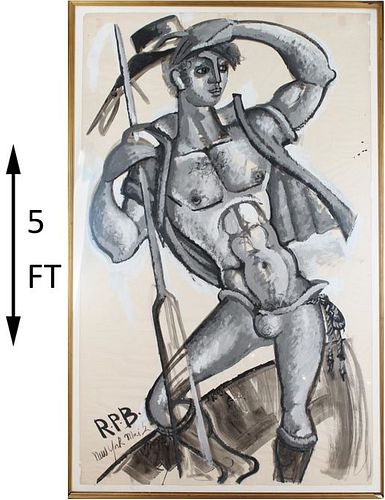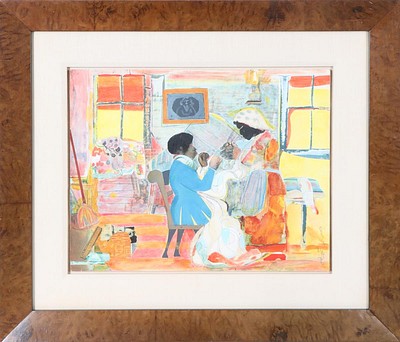LG Raoul Pene Du Bois (1914-1985) NY, Gouache
About Seller
522 South Pineapple Avenue
Sarasota, FL 34236
United States
Sarasota Estate Auction specializes in a wide variety of furniture, antiques, fine art, lighting, sculptures, and collectibles. Andrew Ford, owner and operator of the company, has a passion for finding the best pieces of art and antiques and sharing those finds with the Gulf Coast of Florida.
Two ways to bid:
- Leave a max absentee bid and the platform will bid on your behalf up to your maximum bid during the live auction.
- Bid live during the auction and your bids will be submitted real-time to the auctioneer.
Bid Increments
| Price | Bid Increment |
|---|---|
| $0 | $10 |
| $100 | $25 |
| $250 | $50 |
| $1,000 | $100 |
| $2,500 | $250 |
| $7,500 | $500 |
| $20,000 | $1,000 |
| $50,000 | $2,500 |
| $100,000 | $5,000 |
| $250,000 | $10,000 |
About Auction
Jul 24, 2022
Preview Week Monday, July 18th through Friday, July 22nd from 10 A.M. to 4 P.M. Sarasota Estate Auction sarasotaestateauction@gmail.com
- Lot Description
Raoul Pene Du Bois. “Grisaille Portrait of Sailor Youth” (Mid 20th Century). Signed Gouache Painting on Antique Paper. Born 1914 Staten Island, New York, USA Died 1985 New York, New York, USA Raoul Pene Du Bois was an American set and costume designer and the creative force behind much of Broadway’s visual charm and Hollywood’s fashion-forward allure during the mid twentieth century. In the 1930’s Du Bois was responsible for costuming several annual revues of the Zigfield Follies on Broadway. In the 40’s, Du Bois was nominated for two Academy Awards in the category of Best Art Direction for his work on films. In the 50’s, he dressed the cast of the iconic, runaway Broadway hit, Gypsy—A Steven Sondheim musical first starring Ethel Merman (Anything Goes, Annie Get Your Gun, Hello, Dolly!). In the 60’s, Du Bois was hired as the head costume designer for the film version of Gypsy, starring Rosalind Russel (His Girl Friday, Auntie Mame, Wonderful Town). And finally in the last decade of his life, he styled Ruby Keeler (42nd Street) and the rest of the ensemble cast in the Broadway smash hit, No, No, Nanette. In all, Raoul Pene Du Bois was nominated for six Tony’s, two of which he won—one for Best Costume Design for No, No, Nanette and one for Best Scenic Design in Wonderful Town. This piece by Du Bois, Grisaille Portrait of Sailor Youth, is particularly interesting because it combines some very classic art historical techniques with Du Bois background in theatre and his cinematic sensibility. The scale is monumental, very nearly life-size, which cements its dramatic presence. However the practice of grisaille (French for “grayed” and meaning in English “painted in all gray”) is actually a millennia-old method of painting first popularized during the Northern and Italian Renaissance in pieces like Van Eyck’s Ghent Altarpiece (1432) and Giotto’s Scrovegni Chapel (1305) respectively. Similarly, the sailor’s stance on the prow of his boat is quintessential contrapposto—the Italian word to describe the posture of a subject in a work of art where the upper body is twisted away from the legs and hips on the axial plane. Contrapposto was developed over 2,000 years ago during the golden age of Hellenistic sculpture around 400 BCE and is considered today to be one of the greatest and most lasting achievements of Ancient Greek Art. Perhaps the most famous example of contrapposto is Michelangelo’s David and certainly this piece by Du Bois, Grisaille Portrait of Sailor Youth, evokes a similar aura of youthful eroticism and Adonic male beauty. Lastly, the flat, angular bridge of the nose along with the simple, geometric delineation of the abdominal musculature are piercingly reminiscent of the faces and bodes in Picasso’s Self Portrait (1907) and Standing Female Nude (1908). Du Bois’s style of painting is not outright Cubism, but the influence of Picasso is evident. It is likely that this piece could have been a sketch for a costume design or even a prop or backdrop on one of Du Bois’ many sets that he managed. However we can never rule out the possibility that he intended Grisailles Portrait of Sailor Youth as a stand-alone painting. What is certain is that Du Bois’ creative vision shaped American film and theatre during the twentieth century and after his untimely stroke in 1985, the New York Public Library acquired his archives given his significant cultural impact and contributions the the nation’s arts and letters. Grisailles Portrait of Sailor Youth is a unique piece by a Broadway giant that combines daring eroticism, theatrical flair, and a masterful knowledge of art historical techniques in order to render this work at once radically fresh and rooted firmly in tradition. Overall Size: 62 x 40 in. Sight Size: 58 x 36 in.
- Shipping Info
-
SHIPPING INFORMATION·
Sarasota Estate Auction IS NOT RESPONSIBLE FOR SHIPPING. All shipping will be handled by the winning bidder. Sarasota Estate Auction recommends obtaining shipping quotes before bidding on any items in our auctions. If you are interested in obtaining any information on local shippers, please send us an email and we will kindly send you a list of local shippers. Refunds are not offered under any circumstances base on shipping issues, this is up to the buyer to arrange this beforehand.
Premier Shipping, info@premiershipment.com
-
- Payment & Auction Policies
-
Available payment options
We accept all major credit cards, wire transfers, money orders, checks and PayPal. Please give us a call at (941) 359-8700 or email us at SarasotaEstateAuction@gmail.com to take care of your payments.
-
- Buyer's Premium



 EUR
EUR CAD
CAD AUD
AUD GBP
GBP MXN
MXN HKD
HKD CNY
CNY MYR
MYR SEK
SEK SGD
SGD CHF
CHF THB
THB





















